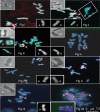Alien introgression in the grasses Lolium perenne (perennial ryegrass) and Festuca pratensis (meadow fescue): the development of seven monosomic substitution lines and their molecular and cytological characterization
- PMID: 21486927
- PMCID: PMC3101149
- DOI: 10.1093/aob/mcr083
Alien introgression in the grasses Lolium perenne (perennial ryegrass) and Festuca pratensis (meadow fescue): the development of seven monosomic substitution lines and their molecular and cytological characterization
Abstract
Background and aims: To address the issues associated with food security, environmental change and bioenergy in the context of crop plants, the production, identification and evaluation of novel plant phenotypes is fundamental. One of the major routes to this end will be wide hybridization and introgression breeding. The transfer of chromosomes and chromosome segments between related species (chromosome engineering or alien introgression) also provides an important resource for determining the genetic control of target traits. However, the realization of the full potential of chromosome engineering has previously been hampered by the inability to identify and characterize interspecific introgressions accurately.
Methods: Seven monosomic substitution lines have been generated comprising Festuca pratensis as the donor species and Lolium perenne as the recipient. Each of the seven lines has a different L. perenne chromosome replaced by the homoeologous F. pratensis chromosome (13 L. perenne + 1 F. pratensis chromosome). Molecular markers and genomic in situ hybridization (GISH) were used to assign the F. pratensis chromosomes introgressed in each of the monosomic substitutions to a specific linkage group. Cytological observations were also carried out on metaphase I of meiosis in each of the substitution lines.
Results: A significant level of synteny was found at the macro-level between L. perenne and F. pratensis. The observations at metaphase I revealed the presence of a low level of interspecific chromosomal translocations between these species.
Discussion: The isolation of the seven monosomic substitution lines provides a resource for dissecting the genetic control of important traits and for gene isolation. Parallels between the L. perenne/F. pratensis system and the Pooideae cereals such as wheat, barley, rye, oats and the model grass Brachypodium distachyon present opportunities for a comparison across the species in terms of genotype and phenotype.
Figures



References
-
- Alm V, Fang C, Busso CS, et al. A linkage map of meadow fescue (Festuca pratensis Huds.) and comparative mapping with other Poaceae. Theoretical and Applied Genetics. 2003;108:25–40. - PubMed
-
- Armstead IP, Turner LB, King IP, Cairns AJ, Humphreys MO. Comparison and integration of genetic maps generated from F2 and BC1-type mapping populations in perennial ryegrass. Plant Breeding. 2002;121:501–507.
-
- Armstead IP, Turner LB, Farrell M, et al. Synteny between a major heading-date QTL in perennial ryegrass (Lolium perenne L.) and the Hd3 heading-date locus in rice. Theoretical and Applied Genetics. 2004;108:822–828. - PubMed
-
- Armstead IP, Donnison IS, Aubry S, et al. From crop to model to crop: identifying the genetic basis of the stay-green mutation in the Lolium/Festuca forage and amenity grasses. New Phytologist. 2006a;172:592–597. - PubMed
-
- Armstead IP, Harper JA, Turner LB, et al. Introgression of crown rust (Puccinia coronata) resistance from meadow fescue (Festuca pratensis) into Italian ryegrass (Lolium multiflorum): genetic mapping and identification of associated molecular markers. Plant Pathology. 2006b;55:62–67. - PubMed
Publication types
MeSH terms
Substances
Grants and funding
LinkOut - more resources
Full Text Sources
Other Literature Sources

